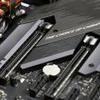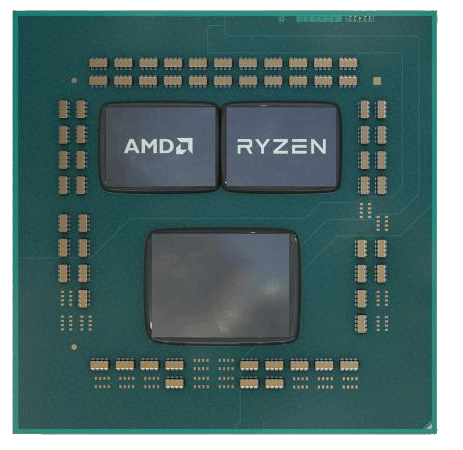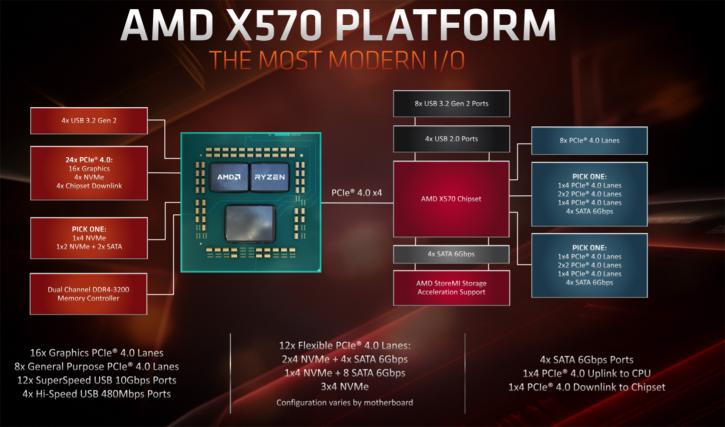Ryzen Generation 3
The Ryzen Generation 3 (Matisse) processors
Early in 2019, AMD has been making a series of announcements on their processor platform, several procs, and the new X570 chipset. We’ll first walk through all that new kit to get you an idea of what’s being released and, of course, talk a bit more about the chiplet design and what that is all about. Meet the processors that are going to be injected into the market over the months to follow:
- 16-core Ryzen 9 3950X will be priced 749 USD (September 2019)
- 12-core Ryzen 9 3900X will be priced 499 USD
- 8-core Ryzen 7 3800X will be priced 399 USD
- 8-core Ryzen 7 3700X will be priced 329 USD
- 6-core Ryzen 5 3600X will be priced 249 USD
- 6-core Ryzen 5 3600 will be priced 199 USD
AMD announced six Ryzen 3000 processors with a spread of six to sixteen core products. Ryzen 3600(X) with six cores and twelve threads, 3700(X) (8t/16t), 3800X (8c/16t) And Ryzen 9 3900X (12c/24t). And that means silicon with two 8-core CPU dies immediately enters the market. AMD promises IPC increases of almost 15% and even 25% when you add the increase in clock frequency. Most Ryzen models will get Turbo bins towards 4.4~4.6 GHz. AMD also announced one flagship processor, the Ryzen 9 3950X, a sixteen core part with thirty-two threads and a Turbo binning towards 4.7 GHz.
|
Ryzen 3000 - Zen Generation 3 die - with 12 or 6 cores it has two 7nm CPU dies, the big one in the middle is the IO chiplet. Combined these are called a chiplet design. |
|||||
|
CPU |
Cores / Threads |
Clock speed/turbo (GHz) |
Cache (total) |
PCIe lanes |
MSRP |
|
Ryzen 9 3950X |
16/32 |
3.5 / 4.7 |
72MB |
40 |
$ 749 |
|
Ryzen 9 3900X |
12/24 |
3.8 / 4.6 |
70MB |
40 |
$ 499 |
|
Ryzen 7 3800X |
8/16 |
3.9 / 4.5 |
36MB |
40 |
$ 399 |
|
Ryzen 7 3700X |
8/16 |
3.6 / 4.4 |
36MB |
40 |
$ 329 |
|
Ryzen 5 3600X |
6/12 |
3.8 / 4.4 |
35MB |
40 |
$ 249 |
|
Ryzen 5 3600 |
6/12 |
3.6 / 4.2 |
35MB |
40 |
$ 199 |
Let's walk through the procs for a minute. AMD has announced new 6, 8, 12 and 16-core processors for its 3rd gen, 7nm fabbed CPUs. The Ryzen 9 3950X is the all-new sixteen core part (due for release/availability in September). The new flagship consumer processor will have 16 cores and 32 threads with a massive 4.7 GHz Boost, its base frequency sits at 3.5 GHz though, but it has no less than 72MB cache, AMD is keeping the power consumption under control at 105 Watts (!).
Ryzen 9 3900X will have 12 cores and 24 threads with a 4.6 GHz Boost, its base frequency sits at 3.8 GHz, AMD is keeping the power consumption in check, also at 105 Watts. AMD sees this proc as a competitor for the Core i9 9920X.
Next in line is probably what will attract the PC gaming community best, a spicy eight-core processor with sixteen threads, the Ryzen 7 3800X. This processor may boost to 4.5 GHz and gets a 3.9 GHz base clock frequency. It has 36 MB total cache and is the proc that AMD pits against the Core i9 9900K. This proc is also listed as having a 105 Watt TDP.
At 329 USD the Ryzen 7 3700X might be the new moneymaker and bestseller as it offers that really nice balance between features, perf, and pricing. This processor also has 8 cores, 16 threads but only runs 100 MHz less on the boost frequency. With a 3.6 GHz base and an unlocked multiplier, this might be the new processor to get if you yearn for 8 processor cores (and remember, that's 16 threads). This processor has a really low 65 Watt TDP thanks to its lower base frequency. The processor has already been shown on stage and has been compared to a Core i7 9700K (and was significantly faster) with roughly similar single threaded performance. So yes, until a non-X model of the 3700 is released, this proc imho is likely to bring a smile to the faces of many.
AMD is also releasing the Ryzen 5 3600 series with initially two products, both have six cores and twelve threads and sit in a 200~250 USD price bracket which is going to serve the mainstream segment excellently. Above, a breakdown of the processors announced. Both hexa-cores get SMT (Hyper-threading) and thus twelve threads. They are rated at a 95W TDP for the 3600X and just 65W for the 3600. The 3600 costs 199 dollars and the 3600X, 249 dollars.
DDR4 memory support
AMD’s DDR4 support is good these days, and with Ryzen 3000 it's expected to become great - pretty much all brands are supported, with an increase in frequency support as well as a drop in latency. For Ryzen 3000 the memory is set up in a dual-channel configuration. All processors support standard DDR4 memory with clock speeds of 3200MT/s (JEDEC). Please note this: As soon as you go higher than DDR4-3733, a 2:1 multiplier will kick in and Infinity Fabric starts working at half the memory clock frequency. The 2:1 multiplier switches on at DDR4-3733 so do keep in mind that it will have an effect on the speed at which the various core complexes within the CPU can communicate with each other. For the best overall system performance, AMD, therefore, recommends DDR4-3600 speed. If you're an overclocker then the result is that you can tweak the memory much further than you're used too. We heard AMD mentioning that DDR4-4200 is very doable. We’ve seen announcements with support for up-to 5100 MHz (OC). Memory latency has been further reduced by 33ns, and that can drive up game performance. Obviously, always check with your mainboard manufacturer if the DDR4 modules are supported, they often offer a QVL list.
Ryzen 3000 (Matisse) delivers 24 lanes PCIe 4.0
Ryzen 3000 CPUs will have a total of 24 PCIe Gen4 lanes, yes, Gen 4.0. Four out of the twenty-four are used for the interconnect to the X570 chipset, leaving 20 lanes Gen 4.0 for other utilization. 16 lanes (PCIe x16) are intended for graphics cards that are connected as x16 or two at x8. Seen from Gen 3.0 one a Gen 4.0 x8 link would offer similar to PCIe 3.0 x16 bandwidth. Four more PCIe lanes from the CPU are designed for fast storage such as PCIe 4.0 NVMe compatible SSDs. In addition to all that, a sidenote - AMD has integrated USB 3.2 Gen2 support into the CPU, that means you get four 10 Gbps USB ports at SuperSpeed.
The X570 chipset delivers another 16 lanes PCIe 4.0
When we move to the X570 chipset, it offers 16 additional lanes of PCIe Gen 4.0, these can be re-routed and shared. Per motherboard, things are going to be connected differently. PCIe slots, M.2 SSDs, LAN, card readers or WiFi modules are to be connected via the new interface standard. The configuration depends on the respective motherboard. Unlike the X370 and X470, the AMD X570 chipset was designed by AMD themselves and here's an interesting fact, the I/O chip that is mounted on the Ryzen 3000 processors and the AMD X570 chipset are in fact the same chips, CPUs make use of the Global Foundries 12nm version and the X570 chipset variant is the same thing, just fabricated on a 14nm process. Since the processor actually has that 12nm IO chip, which is the same as the X570 chipset, it will also offer 4x USB 3.2 Gen 2 (Superspeed 10 Gbps) ports.
| PCIe Version | Line Code | Transfer Rate | x1 Bandwidth | x4 | x8 | x16 |
|---|---|---|---|---|---|---|
| 1.0 | 8b/10b | 2.5 GT/s | 250 MB/s | 1 GB/s | 2 GB/s | 4 GB/s |
| 2.0 | 8b/10b | 5 GT/s | 500 MB/s | 2 GB/s | 4 GB/s | 8 GB/s |
| 3.0 | 128b/130b | 8 GT/s | 984.6 MB/s | 3.938 GB/s | 7.877 GB/s | 15.754 GB/s |
| 4.0 | 128b/130b | 16 GT/s | 1.969 GB/s | 7.877 GB/s | 15.754 GB/s | 31.508 GB/s |
X570 PCH actually includes sixteen PCIe lanes, in addition to the 24 PCIe lanes on the CPU, with a total of 4 (four) 4-lane physical interfaces (4x PCIe 4.0 x4 PHY), fully configurable in PCIe x16, x8, x4, x2, x1, and SATA modes. The X570 chipset offers 8x USB 3.2 Gen 2, 4x USB 2.0, 4x SATA and 8 separate PCI-Express 4.0 lanes. That leaves eight flexible lanes that can be used for PCI-Express and SATA. As you can see, the flexible design allows motherboard manufacturers lots of options in what they want to offer. When you think about it, an AMD X570 motherboard could even get four M.2 slots for PCI-Express 4.0 x4 SSDs. Please do keep in mind that only Ryzen 3000 (Zen2) will open up X570 to the CPU at PCIe 4.0 x4. If a Ryzen 3000 family proc is used or, say, an APU based on older architecture, the chipset connection will become PCIe 3.0. In the end, the X570 platform will be AMD's most advanced offering ever. It is leading over what Intel offers. The downside of all this new technology is that the motherboards are more complicated and expensive to fabricate. Expect starting prices hovering at 200 USD.



